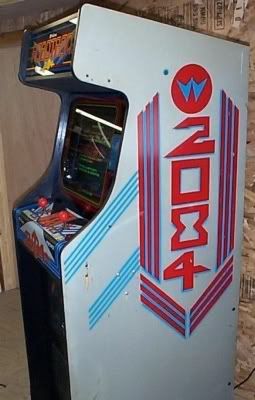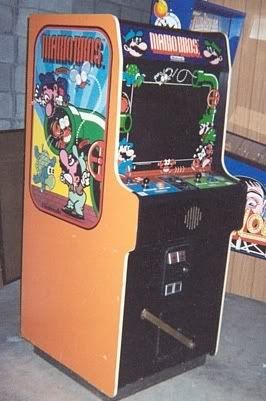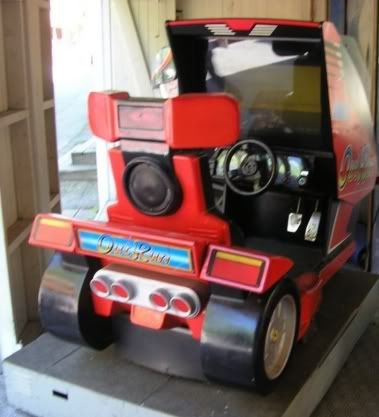The Good, the Bad, and the Mediocre
1980's Arcade Games
THE GOOD: Robotron 2084

"You are the last hope of mankind. Due to a genetic engineering error, you possess superhuman powers. Your mission is to stop the Robotrons and save the last human family!"
I want to transport all of you to another land in a simpler time, when people used payphones and conflict in the Middle East was handled by the CIA. The year was 1982 and video games were all the rage. Not that dinky Atari 2600 or the awful Odyssey home video game system, but stand-up arcade machines, available in every pizza place, stationery store, and highway rest stop around the country. Kids would line up at these machines, plunk their quarters down on the screen to signify their place in line, and watch the vibrating pixels on the screen dance erratically while attempting to figure out just what they were supposed to represent.
One of the pluses of having to build a cabinet for a video game, rather than something on your Playstation, is that you can create a unique interface that compliments the game well. One isn't constrained within the same d-pad, button, button interface that complies with the home system. And so it was with Robotron 2084, perhaps the most fun and most difficult arcade game of all time. Robotron didn't have any cumbersome buttons or triggers, just two joysticks: one for moving the character, the other for aiming his weapon. The weapon was on constant auto-fire. Your bug-eyed character rolled around the screen, shooting a variety of increasingly difficult Robotrons while simultaneously scooping up the members of the last human family, which were sprites that resembled a dad with a briefcase, a mom in a housecoat, and two kids. Really, you could just tell that they weren't Robotrons and therefore needed saving. And that's the game. No sequential story line, no bonus levels or long ending animations, just you vs. the fucking Robotrons, screen after screen after screen. Save the last human family, and start all over again on a new, much harder screen. Eventually, the screen would be so crowded with Robotrons, it was virtually impossible to win. When you're paying a quarter a pop to play the game, that's the best strategy to follow.
THE BAD: Mario Bros.

The world's most recognized and lucrative video game franchise had a pretty lame beginning. First appearing in the blockbuster game Donkey Kong, our little stereotypical friend Mario seemed destined for greatness. Like Will Smith, we can look at the body of Mario's work and say it has been good, overall. Also like Will Smith, we can admit that Mario has been tied to some pretty weak projects. And so it was with his sophomore effort, Mario Bros., which introduced his similarly-greasy brother Luigi. The object of the game is to run around a screen and disable a ceaseless stream of turtles, crabs, and bugs by hitting the ground underneath them. That's all she wrote. It was as dull on board forty as it was on board one. Later, this fraternal duo would pop some magic mushrooms and go Super, but before that, these guys were strictly squares.
THE MEDIOCRE: OutRun

I have trouble calling this game mediocre, because at the time it was the shit. There was a stand-up version and the one pictured, a sit-down realistic version with hydraulic suspension to simulate the car's movement (mostly its crashing). The latter version is the first game I remember that cost fifty cents to play. For a nine year-old, though, it was well worth the experience to drive. Along oceanside highways, across mesa-strewn deserts, you could drive. Take the right fork, take the left fork, drive. Drive, drive, drive. That's all that happened in this game. You were in a Ferrari Testarossa doing 180 miles per hour, and Volkswagen bugs would still blow past you from time to time. After a while, the excitement of driving this pixellated landscape wore off, and you were left with the feeling of having dumped five bucks in quarters to watch a very bad cartoon. At least you got to control the radio, you never got to do that in mom's car.
THE GOOD: Robotron 2084

"You are the last hope of mankind. Due to a genetic engineering error, you possess superhuman powers. Your mission is to stop the Robotrons and save the last human family!"
I want to transport all of you to another land in a simpler time, when people used payphones and conflict in the Middle East was handled by the CIA. The year was 1982 and video games were all the rage. Not that dinky Atari 2600 or the awful Odyssey home video game system, but stand-up arcade machines, available in every pizza place, stationery store, and highway rest stop around the country. Kids would line up at these machines, plunk their quarters down on the screen to signify their place in line, and watch the vibrating pixels on the screen dance erratically while attempting to figure out just what they were supposed to represent.
One of the pluses of having to build a cabinet for a video game, rather than something on your Playstation, is that you can create a unique interface that compliments the game well. One isn't constrained within the same d-pad, button, button interface that complies with the home system. And so it was with Robotron 2084, perhaps the most fun and most difficult arcade game of all time. Robotron didn't have any cumbersome buttons or triggers, just two joysticks: one for moving the character, the other for aiming his weapon. The weapon was on constant auto-fire. Your bug-eyed character rolled around the screen, shooting a variety of increasingly difficult Robotrons while simultaneously scooping up the members of the last human family, which were sprites that resembled a dad with a briefcase, a mom in a housecoat, and two kids. Really, you could just tell that they weren't Robotrons and therefore needed saving. And that's the game. No sequential story line, no bonus levels or long ending animations, just you vs. the fucking Robotrons, screen after screen after screen. Save the last human family, and start all over again on a new, much harder screen. Eventually, the screen would be so crowded with Robotrons, it was virtually impossible to win. When you're paying a quarter a pop to play the game, that's the best strategy to follow.
THE BAD: Mario Bros.

The world's most recognized and lucrative video game franchise had a pretty lame beginning. First appearing in the blockbuster game Donkey Kong, our little stereotypical friend Mario seemed destined for greatness. Like Will Smith, we can look at the body of Mario's work and say it has been good, overall. Also like Will Smith, we can admit that Mario has been tied to some pretty weak projects. And so it was with his sophomore effort, Mario Bros., which introduced his similarly-greasy brother Luigi. The object of the game is to run around a screen and disable a ceaseless stream of turtles, crabs, and bugs by hitting the ground underneath them. That's all she wrote. It was as dull on board forty as it was on board one. Later, this fraternal duo would pop some magic mushrooms and go Super, but before that, these guys were strictly squares.
THE MEDIOCRE: OutRun

I have trouble calling this game mediocre, because at the time it was the shit. There was a stand-up version and the one pictured, a sit-down realistic version with hydraulic suspension to simulate the car's movement (mostly its crashing). The latter version is the first game I remember that cost fifty cents to play. For a nine year-old, though, it was well worth the experience to drive. Along oceanside highways, across mesa-strewn deserts, you could drive. Take the right fork, take the left fork, drive. Drive, drive, drive. That's all that happened in this game. You were in a Ferrari Testarossa doing 180 miles per hour, and Volkswagen bugs would still blow past you from time to time. After a while, the excitement of driving this pixellated landscape wore off, and you were left with the feeling of having dumped five bucks in quarters to watch a very bad cartoon. At least you got to control the radio, you never got to do that in mom's car.

0 Comments:
Post a Comment
Subscribe to Post Comments [Atom]
<< Home